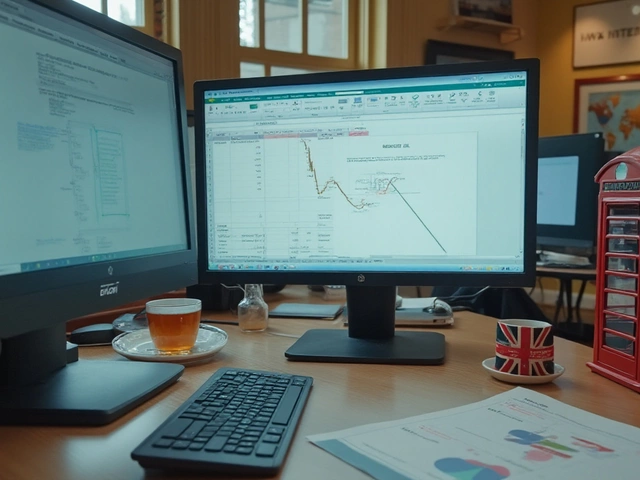If you’re eyeing a career in logistics, the first thing on your mind is probably, “How long is this going to take?” The timeline for earning a logistics degree depends on the level you choose and how you study. There’s no single answer, but I’ll break down what you really need to know so you can plan your next move without second guessing.
Most people start with a bachelor’s degree in logistics or supply chain management, which usually takes four years if you attend full time. But you can get started quicker with an associate degree, which wraps up in about two years at most community colleges. If you’re aiming higher, there are master’s programs that add another year or two, depending on the school and whether you take night or online classes.
It might surprise you, but logistics degrees aren’t just about moving boxes—they cover tech, problem-solving, and a good bit of networking too. The field is booming, and logistics companies are searching for folks who really get how it all fits together. So understanding your timeline isn’t just about punching the clock; it’s about lining up your skills with what companies crave right now.
- Logistics Degrees: The Basics
- Associate vs. Bachelor’s Degree Lengths
- Master’s Programs and Specializations
- Online and Part-Time Options
- What Affects Your Graduation Timeline?
- How a Logistics Degree Boosts Your Career
Logistics Degrees: The Basics
So, what do you get when you sign up for a logistics degree? You're basically learning how goods move from one place to another, but it goes way beyond tracking shipments. Logistics programs teach you about inventory management, warehouse operations, transportation planning, and how companies work with suppliers. It’s a mix of business, tech, and problem-solving that helps keep the world moving.
At most schools, you can pick from a few options: associate, bachelor’s, or even a master’s degree. An associate program usually lasts two years and is great for entry-level jobs. A bachelor’s degree—by far the most popular—opens more doors and takes four years of full-time study. Then there’s the master’s, which gives an extra edge for big-picture roles and leadership, and that’s another one to two years.
Here’s a quick look at how logistics degrees stack up:
| Degree Level | Typical Duration (Full-Time) | Main Focus |
|---|---|---|
| Associate | 2 years | Basics, entry-level skills |
| Bachelor’s | 4 years | Management, tech, business know-how |
| Master’s | 1-2 years | Advanced analysis, leadership |
One thing that draws folks to logistics is flexibility. Many schools now offer online courses or night classes. If you’re already working for a logistics company, you can often go to school part-time and still move forward in your job. Instead of sitting in classrooms all day, you’ll get a lot of hands-on experience and real-world case studies. This means you actually see how supply chains respond to everything from new tech to a sudden spike in orders—stuff that really happens out there.
And don’t worry about being stuck in one industry. Almost every sector needs pros with a logistics or supply chain education—from retail giants and hospitals to e-commerce startups and car makers. That’s a big reason this field is so popular among people who want job options after graduation.
Associate vs. Bachelor’s Degree Lengths
This is where most people start comparing their options. If you don’t want to spend forever in school, an associate degree in logistics or supply chain management might look pretty good. It’s usually just two years full time at a community college or technical school, sometimes even less if you already have some credits under your belt. The main goal? Get you into the workforce fast with the basics you need for entry-level jobs.
Now let’s talk about the bachelor’s degree, which takes four years if you go the traditional route. These programs go deeper: you’ll get more advanced supply chain topics, data analysis, inventory systems, and sometimes paid internships that connect you straight to real logistics companies. More classes mean more options for jobs and higher pay in the long run. Some schools even offer “accelerated” programs, so if you hustle and take summer courses, you could shave up to a year off that timeline.
Here’s how the time and depth typically stack up:
| Degree Type | Usual Length | Main Focus | Typical Roles After Graduation |
|---|---|---|---|
| Associate Degree | 2 years full time | Core logistics, transportation basics, intro to supply chain | Logistics coordinator, inventory clerk, dispatcher |
| Bachelor’s Degree | 4 years full time | Advanced logistics, supply chain management, analytics, leadership | Supply chain analyst, operations manager, logistics planner |
Think about where you want to land. If you just want to get your foot in the door, two years could do it. If you’re aiming for better pay and potential to move up in a logistics company, four years at college opens a lot more doors.
Master’s Programs and Specializations
Going for a master’s degree in logistics or supply chain education is a smart way to move up fast, especially if you want those higher management jobs at logistics companies. Most master’s programs run about 12 to 24 months, depending if you study full-time or stretch it out part-time.
Master’s degrees usually go by titles like Master of Science in Logistics, Supply Chain Management, or Operations Management. Don’t be surprised to see hybrid programs—half online, half in-person. Schools like MIT, Michigan State, and Arizona State are known for strong logistics graduate programs.
Specializations are where things get interesting. You could focus on global logistics, data analytics, procurement, or even sustainability. These targeted tracks make your resume stand out. According to the Council of Supply Chain Management Professionals:
"Advanced logistics degrees open doors to senior roles and bring higher salaries, with top programs offering direct connections to industry leaders."
Many master’s students come from totally different fields—like engineering, business, or IT—so you’re not stuck if you started somewhere else. Here’s what you’ll typically dive into:
- Advanced supply chain technology
- Transportation and distribution management
- Global trade operations
- Inventory and warehouse optimization
- Risk management and logistics strategy
It’s not all theory—most programs include hands-on projects, internships, and even company-sponsored capstone challenges. And if you’re wondering about money, data from the U.S. Bureau of Labor Statistics shows that managers with a master’s in logistics can make up to 20% more than those with just a bachelor’s degree.
| Degree Level | Average Completion Time | Expected Salary Boost |
|---|---|---|
| Bachelor's | 4 years | Baseline |
| Master's | 1-2 years | +20% |
If you’re serious about standing out, specializing in an area that matches what big logistics companies need right now (like analytics or international supply chain) can help you leap ahead of the competition.

Online and Part-Time Options
If you have a busy life already—maybe a full-time job or kids to juggle—you don’t have to rule out a logistics degree. Tons of colleges now offer flexible online and part-time programs that fit your schedule, not the other way around. These are real degrees from real universities, not just quickie certificates.
Most online bachelor’s programs in logistics or supply chain management let you log in for lectures, quizzes, and group work whenever you want. That means you can chip away at your degree in the evenings or on weekends. You’ll cover the same material as someone sitting in a campus classroom. A lot of the top programs even use the same professors for both.
Here’s an eye-opener: According to the National Center for Education Statistics, around 40% of all U.S. college students took at least one online class in 2024. For working adults, that number’s even higher because of flexible work-school balance. Some logistics companies, like DHL and UPS, partner with universities to help workers finish degrees online without taking a career break.
“The demand for online logistics programs has doubled in the past five years, especially among people already working in the field,” says Karen Scott, Director of Online Education at Auburn University.
If you choose part-time, you might take two or three classes per semester instead of four or five. That stretches your degree duration out—a bachelor’s might take up to six years instead of four—but you won’t burn out trying to do it all at once.
- Online Option: Flexible, lets you study anywhere, often the same curriculum as in-person programs.
- Part-Time Option: Fewer classes at a time, longer to finish, but easier if you’re working or caring for family.
- Hybrid Programs: A mix of online coursework and hands-on weekends or meet-ups at local centers, blending flexibility with real-world networking.
Quick tip? Always make sure your online program is accredited so logistics companies will value your degree. If a school brags about connections with big logistics firms, that’s a bonus—internships and career fairs can make a big difference.
Is an online or part-time logistics degree different in employers’ eyes? Most say no—as long as the school has a good reputation and you can show hands-on experience, you’re on equal footing with in-person grads.
What Affects Your Graduation Timeline?
Lots of things can change how long it takes to finish your logistics degree. Sure, programs list an average timeline, but real life isn’t always that simple. Let’s break down what actually matters when you’re planning how quick (or slow) you’ll get that diploma in your hands.
- Full-time vs. part-time: Going full-time usually means keeping to the classic schedule—two years for an associate or four for a bachelor’s. If you opt for part-time because you're working or have other commitments, plan for it to take longer. Some folks stretch a four-year program to five or six years this way.
- Transfer Credits: If you’ve taken classes somewhere else—maybe you have military training or random community college credits—find out if they transfer. Some colleges let you skip classes you’ve already completed, saving months or even a year.
- Online Learning: Online and hybrid classes can be a lifesaver if you need flexibility. Some schools offer self-paced options, so motivated students can speed things up big time. Still, not every class is offered online every semester, so check your course schedule carefully.
- Course Load: This one sounds simple, but it matters. If you sign up for extra courses each semester, including summer classes, you can knock out requirements much faster. On the flip side, taking only one or two classes at a time drags the whole thing out.
- Internships and Work Experience: Many logistics degree programs require internships. Sometimes they’re rolled into your class schedule, but some schools want you to do them after you finish core coursework. If you’re already working in logistics, see if you can use your job to fulfill this.
- Academic Performance: This might sound harsh, but failing or withdrawing from classes means you’ll have to retake them, which delays graduation. Keeping on top of assignments and deadlines really does make a difference.
A 2024 survey of supply chain students showed about 57% of graduates said transfer credits or summer courses helped them finish on time or even early. Here’s a quick look at how various paths can impact your graduation timeline:
| Path | Average Duration |
|---|---|
| Full-time bachelor’s (no transfers) | 4 years |
| Full-time with transfer credits | 2.5-3.5 years |
| Part-time bachelor’s | 5-6 years |
| Accelerated/online bachelor’s | 2.5-3 years |
So, the timeline’s flexible, but those choices add up fast—especially if you keep your eye on transfer credits, class loads, and online options. Thinking ahead can save you time and money when chasing that logistics degree.
How a Logistics Degree Boosts Your Career
A logistics degree can make a real difference when it comes to landing a good job and moving up the ladder. Most logistics companies today want candidates with at least a bachelor’s degree, and some management roles even ask for a master’s. The reason? Logistics is no longer just about tracking shipments—it’s about keeping global supply chains moving, making decisions on the fly, and solving problems with the help of real data.
What’s great is that with a logistics degree, you’re not boxed into one type of job. You can work in supply chain management, warehouse operations, inventory control, transportation planning, or even procurement. Many programs now include hands-on learning, using real tools like SAP or Oracle, which are standard in the industry. This experience looks awesome on your resume and gives you talking points in interviews.
On average, entry-level logistics coordinators with a bachelor’s degree in logistics or supply chain management can expect to start with an annual salary between $50,000 and $60,000 in the U.S. And if you gain experience or earn a master’s, those numbers can rise fast—distribution managers or supply chain analysts often pull in $80,000 or more.
| Job Title | Average U.S. Salary (2024) |
|---|---|
| Logistics Coordinator | $54,000 |
| Supply Chain Analyst | $70,000 |
| Distribution Manager | $83,000 |
| Procurement Specialist | $69,000 |
Besides higher pay, logistics jobs tend to offer stability. The industry is growing because companies depend on fast and efficient shipping now more than ever. In fact, according to the Bureau of Labor Statistics, demand for logisticians is projected to keep rising through 2030, especially as more companies try to fix supply chain hiccups exposed by recent global events.
- If you’re looking for even more job options, some logistics degrees offer specializations in areas like sustainability, technology, or analytics. These can open doors in green logistics or high-tech companies.
- Certifications such as the APICS Certified Supply Chain Professional (CSCP) or the Certified in Logistics, Transportation, and Distribution (CLTD) can be stacked on your degree to increase your value in the job market.
If you want your resume to stand out and open up more doors, a logistics degree is probably one of the smartest moves you can make in the supply chain field.





